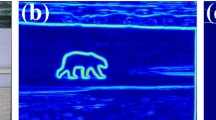Abstract
In this paper, we present an algorithm to combine edge information from stereo-derived disparity maps with edges from the original intensity/color image to improve the contour detection in images of natural scenes. After computing the disparity map, we generate a so-called “edge-combination image,” which relies on those edges of the original image that are also present in the stereo map. We describe an algorithm to identify corresponding intensity and disparity edges, which are usually not perfectly aligned due to errors in the stereo reconstruction. Our experiments show that the proposed edge-combination approach can significantly improve the segmentation results of an active contour algorithm.
Similar content being viewed by others
References
S. Birchfield and C. Tomasi, “Depth Discontinuities by Pixel-to-Pixel Stereo,” International Journal of Computer Vision 35(3), 269–293 (1999).
T. Darrell, G. Gordon, M. Harville, and J. Woodfill, “Integrated Person Tracking Using Stereo, Color, and Pattern Detection,” International Journal of Computer Vision 37(2), 175–185 (2000).
http://www.intel.com/research/mrl/research/opencv (Intel Open Source Computer Vision Library, version 3.1, 2003).
E. Izquierdo, “Disparity/Segmentation Analysis: Matching with an Adaptive Window and Depth-Driven Segmentation,” IEEE Transactions on Circuits and Systems for Video Technology 9(4), 589–607 (1999).
M. Kass, A. Witkin, and D. Terzopoulos, “Snakes: Active Contour Models,” International Journal of Computer Vision 1(4), 321–331 (1987).
B. Nayfeh, “Cellular Automata for Solving Mazes,” Doctor Dobb’s Journal 18(2), 32–38 (1993).
http://www.ptgrey.com (Point Grey Research Inc., 2003).
W. Woo, N. Kim, and Y. Iwadate, “Object Segmentation for Z-keying Using Stereo Techniques,” in Proceedings of ICSP, 2000, pp. 1249–1254.
C. Xu and J.L. Prince, “Gradient Vector Flow: A New External Force for Snakes,” in Proceedings of IEEE Conf. on Comp. Vis. Patt. Recog. (CVPR), Los Alamitos, 1997 (Comp. Soc. Press., 1997), pp. 66–71.
Author information
Authors and Affiliations
Additional information
The text was submitted by the authors in English.
Danijela Markovic graduated from the Faculty of Electronic Engineering, University of Nis, Serbia in 1997. She is currently a PhD student at the Institute for Software Technology and Interactive Systems, Vienna University of Technology. Her research interests are in computer vision and computer graphics, including stereo vision and curve/surface modeling. Particularly, she is interested in object segmentation, feature extraction, and tracking.
Margrit Gelautz received her PhD degree in computer science from Graz University of Technology, Austria. She worked on stereo and interferometric image processing for radar remote sensing applications during a postdoctoral stay at Stanford University. Her current research interests include image and video processing for multimedia applications, with a focus on 3D vision and rendering techniques.
Rights and permissions
About this article
Cite this article
Markovic, D., Gelautz, M. Experimental combination of intensity and stereo edges for improved snake segmentation. Pattern Recognit. Image Anal. 17, 131–135 (2007). https://doi.org/10.1134/S1054661807010154
Received:
Issue Date:
DOI: https://doi.org/10.1134/S1054661807010154




